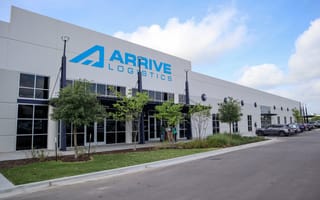Michael Senftleber’s first impression of the beehive of activity at Arrive Logistics is one he won’t soon forget.
“I was sitting on the brokerage floor with all of the brokers who are trying to connect freight from shippers to the right carriers, and it was exciting and fast paced,” he remembered. It was 2019 and Senftleber was on the floor as a consultant to help identify ways to improve the company's logistics supply chain workflow. But the challenge was so invigorating that he eagerly embraced the opportunity to lead the charge to evolve the way Arrive serves its partners. “There was so much opportunity to innovate.”
Now the company’s chief technology officer, Senftleber is focused on building a true technology organization within Arrive Logistics.
“We have product managers, UX designers and engineers,” Senftleber said. “We’re not just taking requirements and handing them off to an engineer. We’re building with purpose and to solve real business problems.”
In doing so, Arrive’s tech function has grown to more than 150 people who make up 12 product teams, including outputs that support their in-house brokers as well as external shippers and carriers.
As the company continues to scale rapidly, Senftleber, Senior Software Engineer Julia Brown and VP of Carrier Strategy Blair Blake shared with Built In Austin what new team members can expect.
The Moment to Innovate
How has Arrive’s business model evolved to become more tech-integrated?
Blake: Arrive started at the logistics load level by creating relationships between shippers and carriers. We would bring in demand and our brokers would source available capacity through phone calls. We still believe there’s a necessity to build relationships and provide this best-in-class service, but now we’ve added the ability to be interconnected with our internal teams and our external partners through technology. For instance, through our carrier portal, we’re able to help a driver whose load was cancelled on a Saturday night locate a new booking option on the spot.
Brown: We also went from using a third-party system that tracked loads to building our own that we could control end-to-end and collect data to power our machine learning pricing models. Now, we have all this data and we’re figuring out how to use it to provide a good user experience.
What are some of the engineering philosophies and practices that Arrive’s team runs on?
Senftleber: We’re not stamping out widgets. This is a technically creative avenue. We’re solving real problems with a product mindset. We have a notion of empowerment that no one here is an order taker. Instead, our teams own a product. They live with that product and maintain it. This allows teams to get deep in their areas of expertise. We don’t think about work as completing something on the day. We think more about what we can do today to make it better in the long term.
Blake: Before we actually ship a product or a technology solution, we go through user acceptance testing and validate everything. We encourage drivers and carriers to give us feedback through various channels and beta tests. Then we work through our internal process again and iterate. It’s our belief that we are not trying to build on the assumption of what our carriers and customers want. We’re talking with them to make sure we’re building according to their needs.
Brown: This tight feedback loop is a lot more interesting than other positions I’ve held
because it allows us to work faster and receive instantaneous feedback. This is the first time I’ve worked somewhere where a large portion of our users are colleagues. I can go to that other building and watch them use our products, which informs our technical decisions. We can see much more clearly what their pain points are.
To have access to stakeholders and users creates a sense of closure and purpose.”
What makes this work appealing for engineers?
Senftleber: You get to see in person how someone is interacting with what you’re building. This allows our engineers to understand how our users are interacting with it, how it meets its intended purpose, if they are enjoying it and if it’s actually addressing their problem. Our engineers, just like everyone in our tech organization, can sit down with people and have lunch with those who are actively using the software.
This real-time feedback creates a sense that what you’re building actually matters. I think a lot of people in tech at some point ask if anyone actually cares about what they are building. To have access to stakeholders and users creates a sense of closure and purpose.
Brown: A new hire’s impact is felt fairly immediately. We’re in a pure growth stage right now and creating new teams and product areas, such as Arrive EDGE for Carriers, our shipper portal, bulk pricing and general infrastructure.
We’re also defining the culture of our engineering group, so every new engineer will play a role in shaping that.
Building From Scratch
What is your team working on at the moment?
Senftleber: In addition to hiring across the board, we’re also investing more in data science to double the team over the next year. This will help us be more efficient and guide us to make the right decisions at the right time. An example of this would be if a shipper asks if they can move a load from A to B next Tuesday. Our matching system, which runs a data science model underneath it, will predict which three carriers are the most likely ones to accept the load, suggest which one to call first and forecast how much it will cost.
We’re also building out a platform that we’ve extended outside of our internal customers to our partners. Now, the carriers can log into our software and interact with our internal folks and the shippers.







